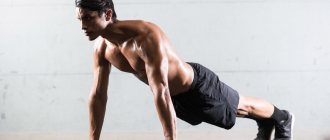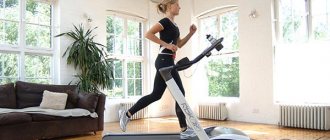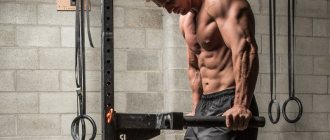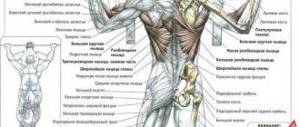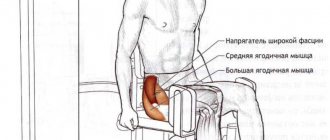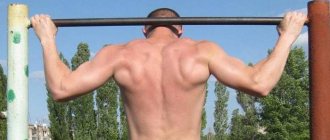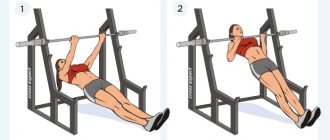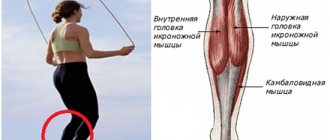Many people want to have a strong physical shape and look beautiful and athletic. But not everyone has the opportunity to visit a gym or organize a sports corner at home. In this case, an excellent exercise will help - push-ups. It can be performed without any additional equipment or sports equipment. To keep yourself in shape, all you need is desire and a well-designed training program. This exercise is universal: men, women, children, and the elderly can perform it. In this article you will learn which muscles are pumped up thanks to push-ups.
- What are the benefits of push-ups?
- What muscles are involved and pumped when doing push-ups?
- Pectoral muscles
- Triceps
- Deltoid muscles of the shoulder
- Serratus anterior muscle
- Abdominal muscles
- Neck
- Basic types of push-ups. Execution technique
- Classic push-ups
- Wide grip
- Wide grip with maximum development of the pectoral muscles
- Medium grip
- Narrow grip
- One-arm push-ups
- Video: 19 types of push-ups for beginners
- Lightweight push-ups
- Knee push-ups
- Do wall push-ups develop muscles?
- What are the effects of complicated push-ups?
- Push-ups with cotton
- Weighted push-ups
- Video: Basic types of push-ups
- Push-up training program for beginners
- Recommendations for performing push-ups. What muscles work
- Video: 3 most serious mistakes when doing push-ups
What are the benefits of push-ups?
Push-ups work different muscle groups. Exercise affects the development of strength indicators and an increase in muscle mass. There are several dozen varieties of push-ups, each of which is aimed at working a specific muscle group. For example, if you do push-ups with your arms spread wide apart (wide grip), the main load will fall on the pectoral muscles. If you do push-ups with a fairly narrow grip, the triceps will be worked the most. More details about the varieties and their execution techniques will be written below.
The essence of the exercise is that you take a strictly horizontal position parallel to the floor, face down. Next, you need to lower and raise your body using flexion and extension movements of your arms. In the classic version, this exercise is performed without the use of additional weights. Only experienced athletes practice push-ups with weights.
The main benefit of the exercise is an increase in muscle mass of certain muscle groups, as well as giving them a sculpted shape. Exercise helps increase strength and endurance. When regularly performing push-ups, the body's metabolism is normalized, which has a positive effect on a person's general condition and well-being.
It is also worth noting that after the age of 30, the human body begins to lose muscle mass: per year, about 2% of muscle mass is replaced by fat. Performing the exercise will stop the loss of muscle mass, develop muscles, improve heart function and reduce the risk of cardiovascular diseases. In addition, push-ups help improve your posture.
Push-up training video in Russian
Complex training: Pectoral muscles + Abs
Top 3 push-ups for chest mass
Push-ups: how to learn to do push-ups
Push-ups are one of the fundamental exercises for strengthening the muscles of the upper body, overall body development, improving functional fitness and endurance. If you are actively involved in fitness at home or in the gym, then be sure to include push-ups in your workout plan.
What muscles are involved and pumped when doing push-ups?
This exercise has a comprehensive effect on the body. What muscles are pumped? The following muscle groups are simultaneously involved:
- the upper and lower parts of the pectoral muscles are well worked out;
- triceps of both arms are involved;
- anterior and middle bundle of deltoid muscles of the shoulder girdle;
- the serratus anterior muscle of the body is worked out;
- upper, lower and lateral abdominal muscles;
- neck.
Push-ups have a complex effect on different muscle groups
Let's look at each muscle group in more detail.
Pectoral muscles
When performing various types of push-ups, the pectoral muscles are the most frequently used. When lifting and lowering the body, it is the pectoralis major muscle that takes the main load. In the everyday life of the average person, the pectoral muscles receive practically no load, so they atrophy very quickly. Push-ups will help activate your pectoral muscles and increase their size.
Triceps
The triceps is responsible for extending the arms. It is the second most important muscle that is used when performing push-ups. Depending on the grip width, the load on the triceps will change when performing the exercise. The narrower the grip, the greater the load.
Deltoid muscles of the shoulder
The deltoid muscles consist of three bundles (posterior, anterior and middle). When performing push-ups, part of the load goes to the anterior and middle bundle of the deltoid muscles of the shoulder. The deltoids help the pectoral muscles lift the body during push-ups.
Serratus anterior muscle
When performing push-ups, this subtle but very important muscle of the human body, which is located in the back of the sternum, works and strengthens.
Abdominal muscles
The abs consists of several muscles that are involved when performing the exercise. It is the abs that help keep the body in an even position when doing push-ups, so it can give the abs a certain definition.
Neck
When performing push-ups from the floor, your head should be level, your gaze directed strictly at the floor. Thanks to this, the neck muscles are also involved in the work.
The remaining muscle groups (biceps and back muscles) are involved to a minimal extent during push-ups.
Safety when doing push-ups
Push-ups, like most other bodyweight exercises, are relatively safe. This means that if more or less correct technique is followed and the practitioner has common sense and an instinct for self-preservation in his head, push-ups will not lead to any injuries. A curved spine (when you lift your head or butt) can lead to compression of the nerves by the vertebrae or other minor neurological problems, and if you position your hands in an awkward manner, you can strain your joints or even fall to the floor at the most crucial moment. Therefore, as always, approach the exercises responsibly, and sooner or later push-ups will become your favorite exercise.
I would like to mention two questions that often concern beginners.
Question: Why does my lower back hurt, although the main load falls on my arms?
Answer: most likely this is caused by weak lower back and abdominal muscles, which do not support the spine well. Over time, your lower back will get used to it, but I advise you to pay more attention to these lagging muscles during training.
Question: Why do my head and neck hurt?
Answer: Most likely, this is caused by some problems in the cervical spine (for example, muscle spasm) or weak blood vessels. Consult your doctor and he can help you tailor your program to suit your case. Check whether you are holding your head correctly during the exercise.
Basic types of push-ups. Execution technique
There are many varieties of push-ups, each of which is aimed at working a specific muscle group. Let's look at the most basic options.
Classic push-ups
The most common type of push-up
The classic version of push-ups is taught at school during physical education classes. The technique is quite simple:
- First, a lying position with support on your palms and toes is adopted.
- Legs and back are one straight line.
- The palms are located slightly wider than the shoulders. The fingers are not widely spaced and point forward.
- Feet together or hip-width apart.
- As you inhale, slowly bring your chest toward the floor, bending your elbows. Don't spread them too far apart.
- Exhale and return to the starting position.
Wide grip
This exercise works the pectoral muscles
The technique is similar to the previous one with some exceptions:
- Hands should be placed at a distance equal to approximately two shoulder widths.
- Elbows should be directed to the sides.
- You can gather your palms into a fist or do push-ups with open palms, as in the classic version.
- The legs are shoulder-width apart or slightly narrower.
- When lowering your body, you need to watch your elbows: they should always look to the sides.
- Your back, neck and head should form one straight line.
If you bend or stick out your buttocks, the effectiveness of the exercise will be significantly reduced. A wide grip allows you to maximally pump the pectoral and deltoid muscles.
Wide grip with maximum development of the pectoral muscles
Wide grip with maximum development of the pectoral muscles
This type of push-up is aimed at maximizing the development of the pectoralis major muscle. The technique is the same as in the case of a wide grip, only the legs must be placed on a hill. For beginners, a stand of 30–35 centimeters will be sufficient. Professionals can do push-ups with a stand of 60 centimeters. The higher the stand, the greater the load on the pectoral muscles. You can experiment with the width of your grip. The wider the grip, the greater the load.
Medium grip
This type of push-up is aimed at working the triceps.
The effectiveness of the exercise will depend on the correct placement of the hands.
- Hands should be placed strictly at shoulder level.
- The elbow joints should be directed back.
- Feet together.
- When lowering the body, the elbows move not to the sides, but back along the body.
- The body must be positioned strictly parallel to the floor.
- You can do push-ups on both your palms and your fists.
Narrow grip
Works the triceps and shoulder girdle well
A narrow grip promotes good development of the triceps and anterior deltoid muscles.
- The palms are located next to each other and directed slightly inward.
- Feet are shoulder-width apart or together.
- When lowering the body, the arms bend along the body, and do not diverge to the sides.
One-arm push-ups
This exercise works well on the pectoral and abdominal muscles.
Doing push-ups on one arm is quite difficult; you should switch to this version of the exercise only if classic push-ups do not provide enough load.
- To maintain balance, you need to spread your legs wide apart.
- The supporting arm is located at the shoulder line, and the other arm is slightly bent and placed behind the back.
- When the descent phase occurs, the elbow bends to the side.
- You can do push-ups, alternating your hand after each push-up, or do a few reps on one hand and then change your supporting hand.
How to learn to do push-ups from scratch
You say, “But I can’t even do one push-up, how can I learn?” Ok, anything can happen, and here’s a tip that will help you learn how to do push-ups. Since the classic push-up is a complex and, to a certain extent, complex movement, it should be simplified as much as possible and gradually return to the original, correct version.
Start with wall push-ups. Just like standard push-ups, place your hands shoulder-width apart (even wider) on the wall and straighten your body. Take one or two steps back until you feel that the bulk of your body weight is in your arms. Now gently lower yourself towards the wall, bending your elbows until your nose almost touches the wall. Freeze for a split second and straighten up with a jerk.
Perform 4 sets of wall push-ups with a two-minute rest between sets, note your progress, and once you reach 20 reps on each set, move on to the next stage. I don’t even remind you that these 80 push-ups should be technically correct.
The next step is push-ups.
The support is a table, chest of drawers, bench or something like that, that is, it is no longer a wall, but not yet a floor. In my opinion, the optimal support at this stage will be a standard desk or kitchen table with a height of 75 cm. The technique for performing push-ups from a support is absolutely the same as before, except that due to the changed angle it will be more difficult for you to lower your body to the support than to walls.
Once you reach the desired number of 4x20 repetitions, go even lower. A low bench, box, log, or ladder steps may work for you. In general, the ladder allows you to lively evaluate your progress in push-ups and the growth of your strength when you start 4x20 push-ups from the fifth step and finish 4x20 from the first. The last level will be the floor.
Lightweight push-ups
For beginners with poorly developed muscles, especially women and the elderly, it can be difficult to perform classic push-ups, not to mention more complicated options. Lightweight push-up options have been developed for them.
Knee push-ups
Suitable for girls with weakly developed muscles
The technique is similar to the classic version, only the legs rest on the knees rather than on the toes. The feet should be crossed and raised above the floor. The workload on the main muscle groups in this position is significantly reduced.
Do wall push-ups develop muscles?
This exercise will strengthen your muscles and prepare them for classic push-ups.
If push-ups from the floor are not easy for you, then you can start with push-ups from the wall.
Technique:
- You need to stand straight in front of the wall at a distance of about one step from it.
- We take the emphasis from the wall.
- The distance between the crayfish should be slightly wider than shoulder level.
- Lift your heels off the floor and perform push-ups.
- When performing the exercise, you must ensure that your body is even.
Recommendations from fitness trainers
Many fitness trainers recommend turning a regular push-up workout into a brutal challenge. Experts advise paying special attention to explosive push-ups.
Explosive push-ups are an exercise where at the top point your hands come off the floor, and at that moment you clap your palms. Athletes are advised to do 10 repetitions of this exercise and then add 3-5 strength exercises on the horizontal bar. If you can’t do a forceful exit, then you need to perform pull-ups with a grip wider than average.
This complex allows:
- Burn calories.
- It's good to work on your endurance.
The rest between two series should be 30-50 seconds. Typically athletes perform 10 series.
Training with additional weight allows you to perfectly load the body as a whole. Experienced professionals advise doing 3-8 approaches until complete failure. As additional weight, you can use a partner or a backpack in which you need to put dumbbell plates or sandbags.
What will it give:
- Thanks to the heavy weight, regular exercise will be an excellent way to grow muscle mass.
- With the extra weight it will be much more difficult to do push-ups. You should try to increase the repetitions, at least by one, with each workout. When you can complete 15 repetitions in one approach, you need to add more weight to your back.
You can do the workout with a ball. Rest between sets should be 1-2 minutes.
Trainers also recommend combining push-ups and speed runs. You need to do 10 rounds in the minimum time. One round includes: 40-50 meter sprint, 30 push-ups and 30 crunches. Rest between rounds is 30-50 seconds.
What will it give:
- Speed running will cause your body to literally explode with the hormones needed for muscle growth. They will be produced in maximum quantities.
- Regular crunches combined with push-ups and sprints will be very difficult to perform.
A mix of strength exercises and running will not only pump up your body, but also dry it out. These tips are intended for athletes of average training level. Beginners should start with simple push-ups. When the body gets used to the load, you can move on to more complex workouts.
What are the effects of complicated push-ups?
Push-ups with cotton
Quite a difficult exercise to work the pectoral muscles
This type of exercise helps not only to work out muscles, but also to increase agility and overall strength.
- The legs are slightly narrower than shoulder width, and the arms are approximately 2 times wider.
- We lower the body and push it up with a powerful push.
- We lift our palms off the floor and clap.
- The landing back should be soft.
- Hands should work rhythmically and energetically.
Weighted push-ups
Weighted push-ups are aimed at increasing muscle mass
Weighted push-ups are aimed at increasing muscle mass and strength in the pectoral muscles and triceps. The additional weight allows you to work the muscle groups quite deeply. As weights for exercise, you can use special sports vests with weights or regular backpacks with weights. The technique is exactly the same as for classic push-ups. You need to start training with small weights (2–3 kilograms), gradually increasing the load. Below you will find an explanatory video.
Correct body position. View from above
Point 1 - and again a very important point of correct technique. Next, I will repeat this more than once. Hands should be at mid-chest level at all times. Avoid making “bows” that occur every time you place your hands at face level.
Only with the correct positioning of the arms does the pectoralis major muscles come into play, which are so large that it is necessary to force them to work and work efficiently. While performing push-ups, you should feel like you are “nodding” to the floor.
“Bowing” further strains those muscles that are tense during office work or computer work, causing even more damage to your posture.
The second caveat: in case of some postural disorders, there is no need to work on the already developed and tight pectoralis major muscles.
On the contrary, they need to be stretched and the back muscles developed.
This is a general recommendation that is very difficult to apply, but still, if you suddenly have constant neck and headache pain, think about a visit to a physiologist and also about adjusting the program.
Point 2 – during the last repetitions (push-ups) of the set, especially if they are difficult for you, control the position of your shoulders.
They tend, when tense, to tend to the ears, involving in any physical work the muscles of the neck and upper trapezius, already tired from life. Try to pull your head up, in the direction of the body line, and your shoulders down, towards your feet.
Push-up training program for beginners
If you are a beginner, it is recommended to exercise every other day (3-4 times a week) to give your muscles time to rest and recover. At the initial stage, you should not overexert your muscles; you can get seriously injured.
A training program for a beginner may look like this:
First training week:
- do a warm-up;
- first training approach - no more than 8 push-ups;
- second training approach - no more than 6 push-ups;
- third training approach - 5 push-ups;
- fourth approach - 5 push-ups;
- if you still have strength, then you can perform 2-3 sets of 5 repetitions;
- Rest between each approach should be 1-2 minutes.
Second training week:
- do a warm-up;
- four sets of 8 push-ups with breaks of 1-2 minutes between sets.
Third training week:
- do a warm-up;
- four sets of maximum repetitions; rest between approaches no more than 1 minute.
You can create subsequent training weeks on your own, gradually increasing the number of push-ups in each approach.
Number of repetitions
If the goal of training is to increase muscle volume, then you need to focus not on the number of repetitions, but on technique and the correct load.
The number of approaches in one workout can be 3-5, in each approach you need to do 8-15 repetitions. You need to work until failure; if your own body weight is not enough, then you need to use a back weight. Rest between sets should be 1.5-2 minutes.
It is recommended to vary the types of push-ups so that the load is shifted to different muscle groups. When doing push-ups with a weight, you need to pay attention to the fact that the load should be located on the back, but not on the lower back, as it can be easily injured.
In addition, you can do push-ups for endurance. The main principle is superload. You should only use light training weights. When performing push-ups, the number of approaches should be 6-8 and the same number of repetitions. Rest is 30 seconds.
Due to a short rest, the load on the body increases, which speeds up metabolic processes and the functioning of the endocrine system. Fat will burn at a tremendous speed. Some professionals call this training “training beyond the will.” The fact is that, despite the small weight of the weight, the training is very difficult.
This type of training has one serious drawback. By training on it, you will not be able to increase muscle volume. The program is aimed primarily at burning fat.
Aesthetic appearance, fine-tuning muscles and drawing deep relief due to high-speed fat burning - that’s what this training system is designed for.
Recommendations for performing push-ups. What muscles work
- When performing push-ups, there should be no discomfort in the elbow and shoulder joints. The joints should not twist; to do this, choose the palm placement that suits you best.
- Push-ups require a certain flexibility, so it is recommended to develop this in parallel with classes.
- To avoid injuring your wrists, do a good warm-up before each activity. In addition, you can use special bandages or sports wristbands.
- If you are planning to gain muscle mass and increase muscle size, then you should pay special attention to nutrition. Food should contain sufficient amounts of protein and vitamins.
